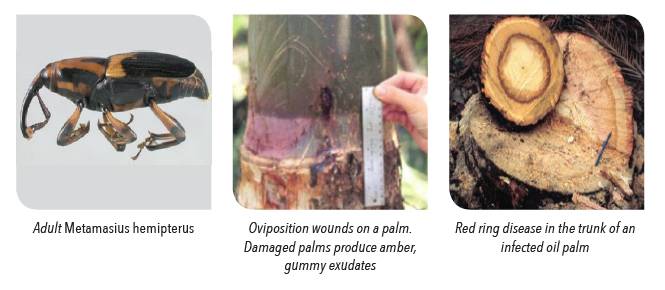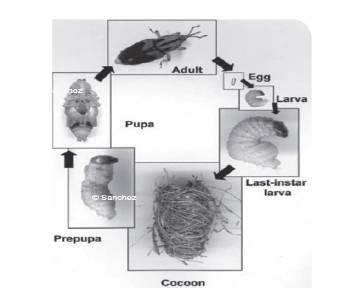General Information

Metamasius hemipterus are generally secondary pests that are attracted to damaged (e.g. rat damage, pruning) or unhealthy host palms. Injured or stressed palms produce kairomones that are attractive to weevil vectors. Females oviposit approximately 500 eggs in cracks or damaged areas of the host plant, or in the petioles or crown shaft of certain species of healthy palms. After eggs hatch, larvae tunnel in the lower stem and rhizome where they destroy maturing stems. Host material is usually already damaged when eggs are laid; however, the larvae bore galleries, which cause additional damage. Also, the oviposition wounds and larval galleries provide further access to further fungal infection/pest invasion. Palms that have been attacked by M. hemipterus often produce amber-colored, gummy exudate at the sites of oviposition wounds. There may also be frass (i.e. chewed plant tissue) protruding from the larval galleries windows at the frond bases.
M. hemipterus is a potential vector for the red-ring disease nematode, Rhadinaphelenchus cocophilus. Palms infected with the red-ring nematode usually die within a few months (2-4 months). Up 10%-15% losses is incurred annually on infested plantations. Heaviest losses occur at the end of the wet season and in the first 2 or 3 months of the dry season. The characteristic symptom of infection is a red, concentric ring that extends throughout in the stem. Other visible symptoms include decline in fruit production, premature nutfall, yellowing and aging of fronds, and the “little leaf syndrome” where fronds are stunted in growth. Red streaks may appear in the petioles, and the roots may turn orange to faint red and become dry and flaky. There is no known treatment for the red-ring disease.
The weevil ingests the nematode while it is still in its larval phase. Adult female weevils deposit the nematodes during oviposition. Nematodes can also be carried on the bodies of the weevils and enter hosts through wounds. Once inside, the nematodes colonise the stems of palm trees, leaf petioles and occasionally in the roots, start feeding and reproducing in palm tissue. The diseased palm starts wilting and eventually dies. The cycle repeats as the weevil larva and pupa co-exist with the nematodes in the host, and are spread once the adult weevil tunnel through the dying host and disperse to healthy palms.
M. hemipterus also attack Saccharum spp., Musa spp. (bananas), pineapples, ornamental palms with soft or fleshy frond bases (e.g. Phoenix canariensis and Ravenea rivularis) and occasionally Cocos nucifera. In coconuts, M. hemipterus has also been implicated in the transmission of a fungus causing leaf-bitten disease.
Distribution
Florida, Caribbean, Mexico, Central and South America, Africa (Cameroon, Congo, Equatorial Guinea, Gabon, and Nigeria).
Detection and Inspection
ADULT
9-14 mm long. Colour variable, entirely black, to black with basal red band of varying extent on elytra, or elytra streaked with red and black longitudinally; pronotum and venter black or various combinations of red and black; femora red, red with black stripes, or red with black bands or smudges. The lifespan for M. hemipterus s is 63 days. Females can produce an average of 52 eggs, 27 days after mating. In temperate regions, one generation occurs per year, while in hot and humid regions, two generations per year is possible. M. hemipterus are strong fliers and can disperse rapidly in fields.
PUPAE
Elongate, narrow and contracted both anteriorly and posteriorly and is approximately 14.5 mm in length. Cocoons are reddish-brown and made from plant fibres.
LARVAE
White, between 3.2 to 4.5 mm wide and 15 to 17 mm long. Thoracic and abdominal sclerites are yellow in color while the head is brown with paler stripes on the dorsal side.
EGGS
Yellowish cream, approximately 1.7 mm long, ovoid and semitransparent.

Prevention and Control
PHYTOSANITARY
The import of germplasm material (seeds, pollen, tissue culture) must be accompanied by an import permit issued by or on behalf of the Director-General of Agriculture for Peninsular Malaysia (including Labuan), or the Director of Agriculture for Sabah, and a phytosanitary certificate issued by an authorised official from the country of export. The import conditions are available upon request from the Plant Biosecurity Division Malaysia. All consignments are subjected to inspection by the Agricultural Department prior to clearance by Customs. Germplasm material imported from high risk areas should be sent for third country quarantine before arrival onto Malaysian shores. The import of alternative host plants e.g. Saccharum officinarum, Cocos nucifera, Phoenix canariensis and Ravenea rivularis from infested areas should be enquired with DOA.
CULTURAL CONTROL AND SANITARY METHODS
The most widely used control method is the capture of adults with traps. Cut bamboo traps with sections filled with masticated and fermenting sugarcane can be used. Trapped weevils to be collected every 48 hr and destroyed.
Further reading
- CABI Plantwise (2015). West Indian cane weevil (Metamasius hemipterus). Url: http://www.plantwise. org/ KnowledgeBank/Datasheet.aspx?dsid=33576.
- Giblin-Davis, R (undated). Biology and management of palm weevils. University of Florida/IFAS. Fort Lauderdale Research and Education Centre.
- Giblin-Davis, R M; Pena, J E; Oehlschlager, A C and Perez, A L (1996). Optimisation of semiochemical-based trapping of Metamasius hemipterus sericeus. J. Chem. Ecol. 22(8): 1389-1410.
- Howard, F W; Moore, D; Giblin-Davis, R M and Abad, R G (2001). Insects on Palms. CABI Publishing: UK. 400 pp.
- Molet, T (2013c). CPHST Pest Datasheet for Metamasius hemipterus. USDA-APHIS- PPQ-CPHST.

